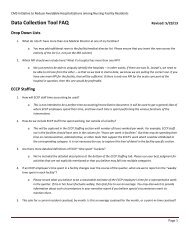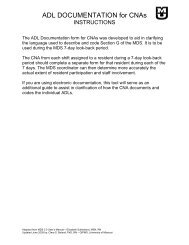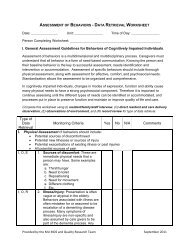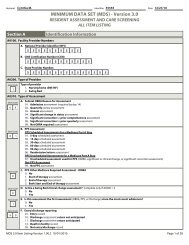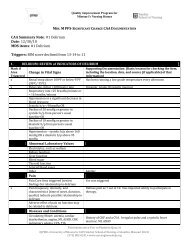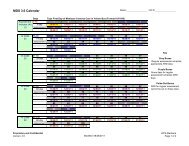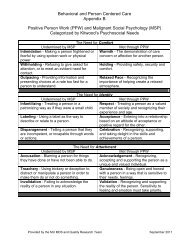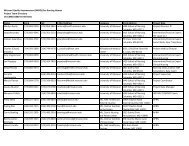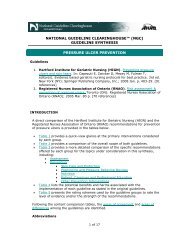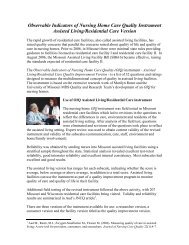Facility Self-Assessment (Mock Survey) Tool - Nursing Home Help
Facility Self-Assessment (Mock Survey) Tool - Nursing Home Help
Facility Self-Assessment (Mock Survey) Tool - Nursing Home Help
Create successful ePaper yourself
Turn your PDF publications into a flip-book with our unique Google optimized e-Paper software.
esidents with vision or swallowing deficits.<br />
Sample Tray Procedure<br />
If residents complain about the palatability/temperature of food served, the survey team coordinator may<br />
request a test meal to obtain quantitative data to assess the complaints. Send the meal to the unit that is the<br />
greatest distance from the kitchen or to the affected unit or dining room. Check food temperature and<br />
palatability of the test meal at about the time the last resident on the unit is served and begins eating.<br />
6. Observe for institutional medication pass practices that interfere with the quality of the residents’ dining<br />
experience. This does not prohibit the administration of medications during meal service for medications that<br />
are necessary to be given at a meal, nor does this prohibit a medication to be given during a meal upon request<br />
of a resident who is accustomed to taking the medication with the meal, as long as it has been determined that<br />
this practice does not interfere with the effectiveness of the medication.<br />
Has the facility attempted to provide medications at times and in a manner to support the dining<br />
experience of the resident, such as:<br />
o Pain medications being given prior to meals so that meals could be eaten in comfort;<br />
o Foods served are not routinely or unnecessarily used as a vehicle to administer medications (mixing<br />
the medications with potatoes or other entrees).<br />
7. Determine if the sampled resident consumed adequate amounts of food as planned.<br />
Determine if the facility is monitoring the foods/fluids consumed. Procedures used by the facility may<br />
be used to determine percentage of food consumed, if available; otherwise, determine the percentage of<br />
food consumed using the following point system:<br />
o Each food item served except for water, coffee, tea, or condiments equals one point. Example:<br />
Breakfast: juice, cereal, milk, bread and butter, coffee (no points) equals four points. If the<br />
resident consumes all four items in the amount served, the resident consumes 100% of breakfast.<br />
If the resident consumes two of the four food items served, then 50% of the breakfast would have<br />
been consumed.<br />
o If three-quarters of a food item is consumed, give one point; for one-half consumed, give .5 points;<br />
for one- fourth or less, give no points. Total the points consumed x 100 and divide by the number of<br />
points given for that meal to give the percentage of meal consumed. Use these measurements when<br />
determining the amount of liquids consumed: Liquid measurements: 8 oz. cup = 240 cc, 6 oz. cup =<br />
180 cc, 4 oz. cup = 120 cc, 1 oz. cup = 30 cc.<br />
o Compare these findings with the facility’s documentation to determine if the facility has<br />
accurately recorded the intake. Ask the staff if these findings are consistent with the resident’s<br />
usual intake; and<br />
o Note whether plates are being returned to the kitchen with 75% or more of food not eaten.<br />
8. If concerns are noted with meal service, preparation, quality of meals, etc., interview the person(s)<br />
responsible for dietary services to determine how the staff are assigned and monitored to assure meals are<br />
prepared according to the menu, that the meals are delivered to residents in a timely fashion, and at proper<br />
temperature, both in the dining rooms/areas and in resident rooms.<br />
NOTE: If concerns are identified in providing monitoring by supervisory staff during dining or concerns<br />
with assistance for residents to eat, evaluate nursing staffing in accord with 42 CFR 483.30(a), F353, and<br />
quality of care at 42 CFR 483.25(a)(2) and (3).<br />
5.71



